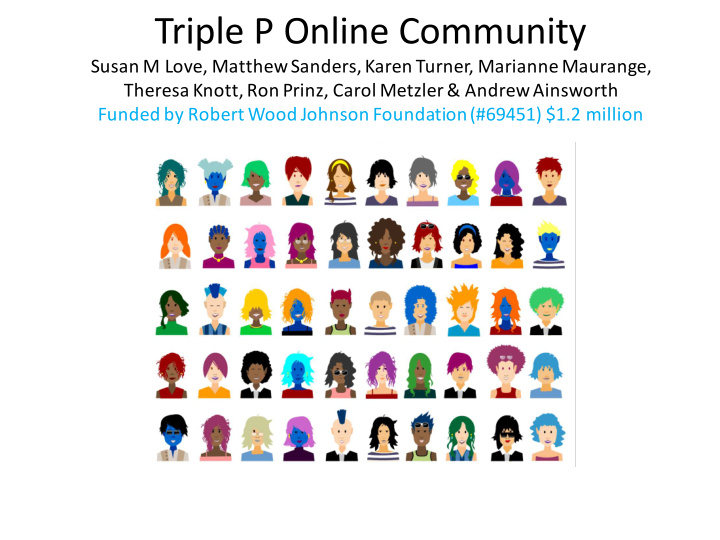



Triple P Online Community Susan M Love, Matthew Sanders, Karen Turner, Marianne Maurange, Theresa Knott, Ron Prinz, Carol Metzler & Andrew Ainsworth Funded by Robert Wood Johnson Foundation (#69451) $1.2 million
The Problem • 10.2% of children are maltreated (CM) [Nearly quarter of a million children in LA!] • CM associated with adverse social/ emotional/ behavioral and health outcomes • Families most at-risk are least likely to seek treatment due to shame & blame • EBP parenting program (Triple P, IY, PCIT) work! • But, a creative solution is needed to reach and engage highly vulnerable families [note see last slide for references]
Research question Will adding social media, games and responsive design to an effective (EBP) online parenting program improve Accessibility, Engagement, Impact for highly vulnerable parents?
Good parenting is as important to children’s health and development as clean water
Sample of highly vulnerable parents
GAMIFICATION—BADGES AND SOCIAL SHARING
RESPONSIVE DESIGN
WHAT DID WE LEARN? Graduation rates équivalent Research question to TPOL Australian study! Adding social media and gaming to TP, it can: 1. REACH 2. ENGAGE & 3. CHANGE PARENT AND CHILD BEHAVIORS (Impact) Also discovered that parents liked it, shared it, and sustained the changes!
Accessibility Parents needed up-to-date computers and browsers • § adequate broadband § and internet literacy education BUT, o connections were often unplugged, overloaded, or weak o some of the agencies restricted parents’ access to computers o on registration day, more than one out of five parents did not have a working email account Regardless of the “digital divide” in the poorest neighborhoods of Los Angeles, parents increasingly, over the year of the intervention phase, accessed TPOC on their smartphones which mitigated broadband barriers and increased participation.
Engagement: sustaining attention long enough to be exposed to intervention Parents could ‘like’ each others posts with stars Facilitator could gild a star—rewarding self-efficacy “ Reassured I was doing something right” ; and “ Got gold stars, that encouraged me”. In focus groups, parents explicitly remarked on the sense of moving through the program as a community, such as: “ I read the opinions of others. They were a great source of support”; and “ I was encouraged when someone moved on to another module, and it made me want to try what they were doing.” The reason that I stayed in the program.”
IMPACT • ECBI Intensity ( F (2,228) = 3.896, p = .022); • CAPES Behavior Scale ( F (2,228) = 3.313, p = .038); • CAPES Emotion Scale ( F (2,228) = 5.534, p = .005); • PS Total ( F (2,230) = 17.141, p < .001), PS Laxness ( F (2,230) = 8.153, p < .001), PS Overreactivity ( F (2,230) = 5.617, p = .004); • DASS-21 Stress ( F (2,228) = 3.648, p = .028). Significant differences on parenting and parental stress were maintained or improved at 6-month follow-up. [ NOTE: Although all in the expected direction, no effects were found on the ECBI Problem scale, CAPES Parental Confidence, PS Verbosity, PACBM attributional measures, or DASS depression or anxiety .]
Blew out the 90-9-1 social media rule
Sharing The majority of our parents shared what they were learning… • Online • With friends and family • In the neighborhood
Place matters We do not know if it was the program’s social media features, or the “buzz” and excitement in the neighborhood that motivated and engaged the parents. Although, this study could not tease out these influences, it does suggest that peer-to-peer enthusiasm whether online or in-person, especially in disadvantaged communities, has a powerful influence.
Place Matters
Cited articles Finkelhor, D., Ormrod, R. K., & Turner, H. A. (2009). Lifetime assessment of poly-victimization in a national sample of children and youth. Child Abuse & Neglect , 33, 403–411. Felitti, V. J., Anda, R. F., Nordenberg, D., Williamson, D. F., Spitz, A. M., Edwards, V., Koss, M. P ., & Marks, J. S. (1998). Relationship of childhood abuse and household dysfunction to many of the leading causes of death in adults: The Adverse Childhood Experiences (ACE) Study . American Journal of Preventive Medicine , 14(4), 245–258. Corrigan, P ., Watson, A., & Miller, F. (2006). Blame, shame, and contamination: The impact of mental illness and drug dependence stigma on family members, Journal of Family Psychology, 20(2), 239-46. de Graaf, I., Speetjens, P ., Smit, F., de Wolff, M., & Tavecchio, L. (2008b). Effectiveness of the TRIPLE P – Positive Parenting Program on behavioral problems in children: A meta-analysis. Behavior Modification, 32, 714–735. http://dx.doi.org/10.1177/0145445508317134 . FINDINGS OF THE RWJF STUDY: Love, S.M., Sanders, M.R., Turner, K., Maurange, M., Knott, T., Prinz, R., Metzler, C. & Ainsworth, A. T. (2016). Social media and gamification: Engaging vulnerable parents in an online evidence-based parenting program. Child Abuse and Neglect , 53, 95-107.
Recommend
More recommend